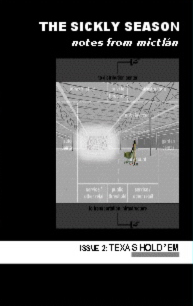

ISSUE 2: TEXAS HOLD 'EM
n o v e m b e r 2005
print media copies are available
for exchange, please send mailing address &
non-monetary gift to address below
I’m somewhere in the middle of Texas, visiting my friend, and I’m surrounded by prisons.
This is a land of prisons—sprawling apartment complex mini-cities, gated communities, barbed-wire fencing, private security guard patrols. Big-box superstore sprawls, immense vessels grounded in antiseptic asphalt seas. Cities within cities. Prisons within prisons. Chinese boxes. Sinking.
And, of course, there is the Texas penal system, the largest in the nation.
“I’m scared,” my friend says.
“Shh, don’t articulate,” I whisper. “It might scar you. Ten to life, minimum.”
So we speak with our eyes. Maximum insecurity, my friend says.
Minimum level prism, I respond.
Black and white, he blinks.
Open close open.
Nearby, a surveillance camera whirs and clicks, shifts position in response to the movement of eyelids, but it is too slow. Already the surfaces of our eyes are windows, mirrors, graffiti-etched glass.
We sit in traffic on the main freeway in Austin, Texas. The freeway runs north and south. It cuts through downtown. It divides the city into two basic sectors. They are the same two sectors replicated in every other city of the United States. Here Cesar Chavez Blvd., and MLK Blvd., run through the polluted parts of town, the poorest parts of town. Here Guadalupe Street runs through polluted mouths, twists and turns on oil-slick tongues, comes out Gwaduhloop. Here you are surrounded by signs that lay it all out clearly, efficiently: The hierarchies, the silencings, the erasures, the boundaries.
“This is ridiculous,” my friend says. “We need to get off this freeway.”
“It’s a proven scientific fact,” I say. “The more you drive, the less intelligent you are. I even heard that in a movie once.”
“How did they avoid it?”
“They learned how to fly. Space. Radioactivity. There’s a certain amount of contamination you will have to endure. But it’s that or this or a bullet through your windshield/head.”
“Fuck that. I’ll take none of the above.”
“But we’re running out of gas and we haven’t moved an inch,” I say.
“Maybe I should step on the gas and the brake at the same time.”
My friend says this last part and we both laugh. We share a memory: Both of us drunk in Los Angeles, my friend behind the wheel of a car he rented for this visit, 2:30 in the morning, and we are ripping down Glendale Boulevard, into Rowena Avenue, and the whole time, the emergency brake is pulled up as far as it will go. When we come to a stop at Hyperion, a thick white cloud surges forward from the rear wheels and engulfs us. A concerned driver in the next lane over honks and points at our rear tires, and we crack up and screech away, trailing a cloud behind us.
“That really happened,” I say. “You really pulled the brake all the way up just to see what would happen.”
“It was not a dream,” my friend says.
“Nope. Not theory. Not some abstract avant-garde metaphor. Drunken praxis on the mean streets of L.A.”
He sighs. “We still haven’t moved. This freeway is going nowhere. Now I know why they shoot you guys on the freeways out there. Mercy killings.”
“That whole city is just a car-full of mutual suicide pacts.”
“Full Capacity, U.S.A.”